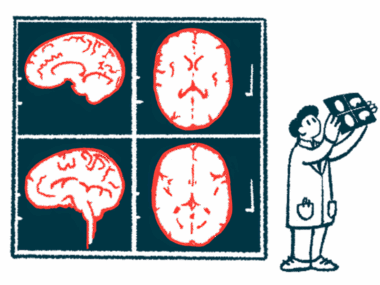Wearable sensors move MS brain imaging beyond MRI machines
OPM-MEG helmet, backpack track real-time brain activity in natural posture
Written by |

A new wearable brain-mapping tool could dramatically change how doctors monitor people with multiple sclerosis (MS), making it easier to track disease progression and guide personalized care.
Researchers showed the system, OPM-MEG, reliably detects abnormalities in the brain’s electrical activity in MS patients. The portable technology is a major improvement over stationary MRI scans, offering the potential to uncover neurological changes underlying symptoms that are currently hard to measure.
The technology “will likely lead to a new understanding of [neurological changes underlying] symptoms (e.g., poor balance) and could ostensibly offer new clinically relevant biomarkers which, for example, could help track disease progression (something that is currently challenging using MRI),” researchers wrote.
The study, “OPM-MEG in multiple sclerosis: Proof of principle, and the effect of naturalistic posture,” was published in NeuroImage: Clinical.
Beyond the limitations of MRI
MS is a chronic disorder marked by inflammation that damages healthy cells in the brain and spinal cord. MRI, which works by looking at structures in the brain to detect signs of damage, is a key tool for monitoring MS activity and progression, but it has some drawbacks. For example, while it can detect physical changes in brain tissue, MRI does not provide much information about the activity of specific brain regions.
In the new study, a team of researchers in the U.K. focused on a different technology called magnetoencephalography (MEG), which works to detect electrical brain activity by measuring the magnetic fields that are generated by neuronal currents in the brain. MEG has been used for decades, but traditional machines are bulky and stationary, generally requiring users to be seated or lying down.
A recent breakthrough in this field was the development of optically pumped magnetometers (OPMs), which are sensors that can be used for MEG that are much smaller than traditional tools. OPMs are “around the size of a sugar cube,” and they are lightweight and don’t require low temperatures to work correctly, the researchers wrote.
Using OPMs, the team developed OPM-MEG, a system that uses a helmet attached to a controller worn like a backpack to detect the brain’s electrical activity. In theory, this technology could allow clinicians to monitor brain activity while patients are up-and-about, which could provide powerful insights into the underlying biology of MS and help to guide personalized care.
“Although there is high promise, OPM-MEG remains a new technology, and it is important that we validate its use for MS,” the researchers wrote.
In their study, the team conducted a series of proof-of-concept tests to show OPM-MEG can reliably detect brain abnormalities in MS patients.
The scientists showed the OPM-MEG system was able to detect certain changes in MS patients that have previously been reported. For example, MS patients generally had less of a type of brain activity called gamma bands in response to visual stimulation, and their beta bands were delayed in response to finger movements.
“OPM-MEG can record how the brain is working in real-time, in a range of postures, and during natural movements,” Ben Sanders, a graduate student at the University of Nottingham and co-author of the study, said in a university news story. “Our paper shows that this unique capability can bring new insights to MS.”
The researchers also used their system to measure brain activity in participants who were both seated and standing. This is “not a ‘movement task’ per se, but it is something that would be impossible using conventional MEG,” the researchers noted.
Results indicated certain types of brain waves changed more in MS patients than in people without the condition when standing. This finding “provides confidence that we can gather high quality data regardless of posture,” the scientists wrote. They stressed that this was a small proof-of-concept test, so more research will be needed to validate the findings and explore these differences further.
“We are now building on this with further research to track brain activity in people with MS over time,” said Christopher Gilmartin, study co-author and professor at the University of Nottingham. “We hope that in the long-term, OPM-MEG may help us predict those individuals whose MS symptoms will get worse, and those who will have more stable disease. Such prognosis would be a significant benefit when treating MS patients.”
The MS Society U.K. is funding additional research into the OPM-MEG system’s use in MS.
“MS is unpredictable and often strikes at a time when people are making big life choices about careers, relationships and family. This new brain-imaging technique could help reveal subtle changes in MS in real time,” said Laura Ohlmeier, senior research communications officer at the MS Society. “In the future, this could help us track and predict progression more accurately, giving people living with MS greater certainty about the future. We’re proud to be funding two new research projects launched this year at the University of Nottingham to further explore this promising technology.”






